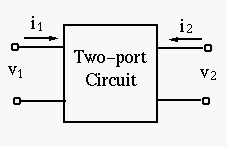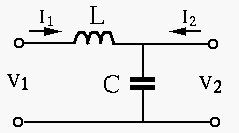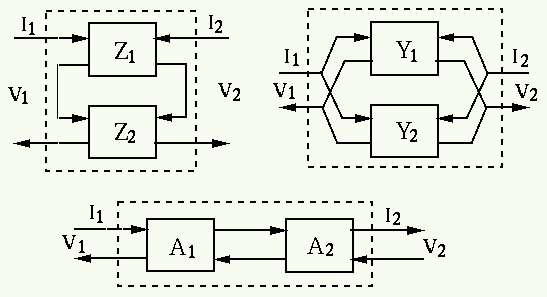Models of two-port networks
Many complex, such as amplification circuits and filters, can be modeled
by a two-port network model as shown below. A two-port network is
represented by four external variables: voltage  and current
and current  at the input port, and voltage
at the input port, and voltage  and current
and current  at the output port,
so that the two-port network can be treated as a black box modeled by the
relationships between the four variables
at the output port,
so that the two-port network can be treated as a black box modeled by the
relationships between the four variables  ,
,  ,
,  and
and  .
There exist six different ways to describe the relationships between these
variables, depending on which two of the four variables are given, while
the other two can always be derived.
.
There exist six different ways to describe the relationships between these
variables, depending on which two of the four variables are given, while
the other two can always be derived.

If the network is linear, i.e., each variable can be expressed as a linear
function of some two other variables, then we have the following models:
- Z or impedance model: Given two currents
 and
and  find voltages
find voltages  and
and  by:
by:
![$\displaystyle \left\{ \begin{array}{l} V_1=Z_{11}I_1+Z_{12}I_2 \\
V_2=Z_{21}I_...
...nd{array} \right]
={\bf Z}\left[ \begin{array}{l} I_1 \\ I_2\end{array} \right]$](img312.svg) |
(78) |
Here all four parameters  ,
,  ,
,  , and
, and  represent
impedance. In particular,
represent
impedance. In particular,  and
and  are transfer impedances,
defined as the ratio of a voltage
are transfer impedances,
defined as the ratio of a voltage  (or
(or  ) in one part of a network to
a current
) in one part of a network to
a current  (or
(or  ) in another part
) in another part
 .
.  is a 2
by 2 matrix containing all four parameters.
is a 2
by 2 matrix containing all four parameters.
- Y or admittance model: Given two voltages
 and
and  ,
find currents
,
find currents  and
and  by:
by:
![$\displaystyle \left\{ \begin{array}{l} I_1=Y_{11}V_1+Y_{12}V_2 \\
I_2=Y_{21}V_...
...nd{array} \right]
={\bf Y}\left[ \begin{array}{l} V_1 \\ V_2\end{array} \right]$](img319.svg) |
(79) |
Here all four parameters  ,
,  ,
,  , and
, and  represent
admittance. In particular,
represent
admittance. In particular,  and
and  are transfer admittances.
are transfer admittances.
 is the corresponding parameter matrix.
is the corresponding parameter matrix.
- A or transmission model: Given
 and
and  , find
, find
 and
and  by:
by:
![$\displaystyle \left\{ \begin{array}{l}
V_1=A_{11}V_2+A_{12}(-I_2) \\
I_1=A_{21...
...d{array} \right]
={\bf A}\left[ \begin{array}{r} V_2 \\ -I_2\end{array} \right]$](img325.svg) |
(80) |
Here  and
and  are dimensionless coefficients,
are dimensionless coefficients,  is impedance
and
is impedance
and  is admittance. A negative sign is added to the output current
is admittance. A negative sign is added to the output current  in the model, so that the direction of the current is out-ward, for easy
analysis of a cascade of multiple network models.
in the model, so that the direction of the current is out-ward, for easy
analysis of a cascade of multiple network models.
- H or hybrid model: Given
 and
and  , find
, find  and
and  by:
by:
![$\displaystyle \left\{ \begin{array}{l}
V_1=H_{11}I_1+H_{12}V_2 \\
I_2=H_{21}I_...
...nd{array} \right]
={\bf H}\left[ \begin{array}{l} I_1 \\ V_2\end{array} \right]$](img330.svg) |
(81) |
Here  and
and  are dimensionless coefficients,
are dimensionless coefficients,  is
impedance and
is
impedance and  is admittance.
is admittance.
Generalization to nonlinear circuits
The two-port models can also be applied to a nonlinear circuit if the
variations of the variables are small (small signal models) and
therefore the nonlinear behavior of the circuit can be piece-wise
linearized. Assume  is a nonlinear function of variables
is a nonlinear function of variables
 and
and  . If the variations
. If the variations
 and
and
 are
small, the function can be approximated by a linear model
are
small, the function can be approximated by a linear model
 |
(82) |
with the linear coefficients
 |
(83) |
Finding the model parameters
For each of the four types of models, the four parameters can be found
from variables  ,
,  ,
,  and
and  of a network by the following.
of a network by the following.
- For Z-model:
 |
(84) |
- For Y-model:
 |
(85) |
- For A-model:
 |
(86) |
- For H-model:
 |
(87) |
If we further define
![$\displaystyle {\bf V}=[V_1, V_2]^T,\;\;\;\;\;\;{\bf I}=[I_1, I_2]^T$](img344.svg) |
(88) |
then the Z-model and Y-model above can be written in matrix form:
 |
(89) |
Example:

Find the Z-model and Y-model of the circuit shown.
 |
(90) |
- First assume
 , we get
, we get
 |
(91) |
- Next assume
 , we get
, we get
 |
(92) |
The parameters of the Y-model can be found as the inverse of  :
:
![$\displaystyle \left[\begin{array}{cc}Y_{11}&Y_{12}\\ Y_{21}&Y_{22}\end{array}\r...
...mega L & -1/j\omega L\\
-1/j\omega L & j\omega C+1/j\omega L\end{array}\right]$](img352.svg) |
(93) |
Note:
![$\displaystyle \left[ \begin{array}{rr} a & b \\ c & d \end{array} \right]^{-1}
=\frac{1}{ad-bc}\left[ \begin{array}{rr} d & -b \\ -c & a \end{array} \right]$](img353.svg) |
(94) |
Combinations of two-port models
- Series connection of two 2-port networks:

- Parallel connection of two 2-port networks:

- Cascade connection of two 2-port networks:


Example: A The circuit shown below contains a two-port network (e.g., a
filter circuit, or an amplification circuit) represented by a Z-model:
![$\displaystyle {\bf Z}=\left[\begin{array}{ll} Z_{11} & Z_{12} \\
Z_{21} & Z_{2...
...[\begin{array}{rr} 4\Omega & j3\Omega \\
j3\Omega & 2\Omega \end{array}\right]$](img357.svg) |
(95) |
The input voltage is
 with an internal impedance
with an internal impedance
 and the load impedance is
and the load impedance is
 . Find the two voltages
. Find the two voltages
 ,
,  and two currents
and two currents  ,
,  .
.

Method 1:
- First, according the Z-model, we have
 |
(96) |
- Second, two more equations can be obtained from the circuit:
 |
(97) |
- Substituting the last two equations for
 and
and  into the
first two, we get
into the
first two, we get
 |
(98) |
- Solving these we get
 |
(99) |
- Then we can get the voltages
 |
(100) |
Method 2: We can also use Thevenin's theorem to treat everything
before the load impedance as an equivalent voltage source with Thevenin's
voltage  and resistance
and resistance  , and the output voltage
, and the output voltage  and
current
and
current  can be found.
can be found.
- Find
 with voltage
with voltage  short-circuit:
short-circuit:
- The Z-model:
 |
(101) |
- Also due to the short-circuit of voltage source
 , we have
, we have
 |
(102) |
- equating the two expressions for
 , we get
, we get
 i.e. i.e. |
(103) |
- Substituting this
 into the equation for
into the equation for  above, we get
above, we get
 |
(104) |
- Find
 :
:
 |
(105) |
- Find open-circuit voltage
 with
with  :
:
- Since the load is an open-circuit,
 , we have
, we have
 |
(106) |
- Find
 :
:
 |
(107) |
Solving this to get 
- Find open-circuit voltage
 :
:
 |
(108) |
- Find load voltage
 :
:
 |
(109) |
- Find load voltage
 :
:
 |
(110) |
Principle of reciprocity:

Consider the example circuit on the left above, which can be simplified
as the network in the middle. The voltage source is in the branch on the
left, while the current  is in the branch on the right, which
can be found to be (current divider):
is in the branch on the right, which
can be found to be (current divider):
 |
(111) |
We next interchange the positions of the voltage source and the current,
so that the voltage source is in the branch on the right and the current
to be found is in the branch on the left, as shown on the right of the
figure above. The current can be found to be
 |
(112) |
The two currents  and
and  are exactly the same! This
result illustrates the following reciprocity principle, which can
be proven in general:
are exactly the same! This
result illustrates the following reciprocity principle, which can
be proven in general:
In any passive (without energy sources),
linear network, if a voltage  applied in branch 1 causes a current
applied in branch 1 causes a current  in
branch 2, then this voltage
in
branch 2, then this voltage  applied in branch 2 will cause the same current
applied in branch 2 will cause the same current
 in branch 1.
in branch 1.
This reciprocity principle can also be stated as:
In any passive, linear network, the transfer impedance  is equal
to the reciprocal transfer impedance
is equal
to the reciprocal transfer impedance  .
.
Based on this reciprocity principle, any complex passive linear network can
be modeled by either a T-network or a  -network:
-network:
- T-Network Model:

From this T-model, we get
 |
(113) |
Comparing this with the Z-model, we get
 |
(114) |
Solving these equations for  ,
,  and
and  , we get
, we get
 |
(115) |
 -Network Model:
-Network Model:

From this  -model, we get:
-model, we get:
 |
(116) |
Comparing this with the Y-model, we get
 |
(117) |
Solving these equations for  ,
,  and
and  , we get
, we get
 |
(118) |
Example 1: Convert the given T-network to a  network.
network.

Solution: Given  ,
,  ,
,  , we get its Z-model:
, we get its Z-model:
 |
(119) |
The Z-model can be expressed in matrix form:
![$\displaystyle \left[ \begin{array}{l} V_1 \\ V_2\end{array} \right]=
\left[ \be...
... 1-j5 \end{array} \right]
\left[ \begin{array}{l} I_1 \\ I_2\end{array} \right]$](img398.svg) |
(120) |
This Z-model can be converted into a Y-model:
![$\displaystyle \left[ \begin{array}{l} I_1 \\ I_2\end{array} \right]=
\left[ \be...
..._{22} \end{array} \right]
\left[ \begin{array}{l} V_1 \\ V_2\end{array} \right]$](img399.svg) |
(121) |
This Y-model can be converted to a  network:
network:
 |
(122) |
These admittances can be further converted into impedances:
 |
(123) |
The same results can be obtained by Y to delta conversion.
Example 2: Consider the ideal transformer shown in the figure below.
Assume
 ,
,
 , and the turn ratio is
, and the turn ratio is
 .
Describe this circuit as a two-port network.
.
Describe this circuit as a two-port network.

- Set up basic equations:
 |
(124) |
- Rearrange the equations in the form of a Z-model. The second equation is
 |
(125) |
Substituting into the first equation, we get
 |
(126) |
The Z-model is:
![$\displaystyle \left[ \begin{array}{l} V_1 \\ V_2 \end{array} \right]=
\left[ \b...
... & 5 \end{array} \right]
\left[ \begin{array}{l} I_1 \\ I_2 \end{array} \right]$](img408.svg) |
(127) |
As
 , this is a reciprocal network.
, this is a reciprocal network.
Alternatively, we can set up the equations in terms of the currents:
-
 |
(128) |
- Rearrange the equations in the form of a Y-model. The first equation is
 |
(129) |
- Substituting into the second equation, we get
 |
(130) |
The Y-model is:
![$\displaystyle \left[ \begin{array}{l} I_1 \\ I_2 \end{array} \right]=
\left[ \b...
... 3/5 \end{array} \right]
\left[ \begin{array}{l} V_1 \\ V_2 \end{array} \right]$](img413.svg) |
(131) |
Finally, we can verify that

![$\displaystyle {\bf Z}^{-1}=\left[ \begin{array}{rr} 30 & 10 \\ 10 & 5 \end{arra...
...\left[ \begin{array}{rr} 1/10 & -1/5 \\ -1/5 & 3/5 \end{array} \right]
={\bf Y}$](img415.svg) |
(132) |









 and
and  find voltages
find voltages  and
and  by:
by:
![$\displaystyle \left\{ \begin{array}{l} V_1=Z_{11}I_1+Z_{12}I_2 \\
V_2=Z_{21}I_...
...nd{array} \right]
={\bf Z}\left[ \begin{array}{l} I_1 \\ I_2\end{array} \right]$](img312.svg)
 ,
,  ,
,  , and
, and  represent
impedance. In particular,
represent
impedance. In particular,  and
and  are transfer impedances,
defined as the ratio of a voltage
are transfer impedances,
defined as the ratio of a voltage  (or
(or  ) in one part of a network to
a current
) in one part of a network to
a current  (or
(or  ) in another part
) in another part
 .
.  is a 2
by 2 matrix containing all four parameters.
is a 2
by 2 matrix containing all four parameters.
 and
and  ,
find currents
,
find currents  and
and  by:
by:
![$\displaystyle \left\{ \begin{array}{l} I_1=Y_{11}V_1+Y_{12}V_2 \\
I_2=Y_{21}V_...
...nd{array} \right]
={\bf Y}\left[ \begin{array}{l} V_1 \\ V_2\end{array} \right]$](img319.svg)
 ,
,  ,
,  , and
, and  represent
admittance. In particular,
represent
admittance. In particular,  and
and  are transfer admittances.
are transfer admittances.
 is the corresponding parameter matrix.
is the corresponding parameter matrix.
 and
and  , find
, find
 and
and  by:
by:
![$\displaystyle \left\{ \begin{array}{l}
V_1=A_{11}V_2+A_{12}(-I_2) \\
I_1=A_{21...
...d{array} \right]
={\bf A}\left[ \begin{array}{r} V_2 \\ -I_2\end{array} \right]$](img325.svg)
 and
and  are dimensionless coefficients,
are dimensionless coefficients,  is impedance
and
is impedance
and  is admittance. A negative sign is added to the output current
is admittance. A negative sign is added to the output current  in the model, so that the direction of the current is out-ward, for easy
analysis of a cascade of multiple network models.
in the model, so that the direction of the current is out-ward, for easy
analysis of a cascade of multiple network models.
 and
and  , find
, find  and
and  by:
by:
![$\displaystyle \left\{ \begin{array}{l}
V_1=H_{11}I_1+H_{12}V_2 \\
I_2=H_{21}I_...
...nd{array} \right]
={\bf H}\left[ \begin{array}{l} I_1 \\ V_2\end{array} \right]$](img330.svg)
 and
and  are dimensionless coefficients,
are dimensionless coefficients,  is
impedance and
is
impedance and  is admittance.
is admittance.















![$\displaystyle {\bf V}=[V_1, V_2]^T,\;\;\;\;\;\;{\bf I}=[I_1, I_2]^T$](img344.svg)



 , we get
, we get

 , we get
, we get

 :
:
![$\displaystyle \left[\begin{array}{cc}Y_{11}&Y_{12}\\ Y_{21}&Y_{22}\end{array}\r...
...mega L & -1/j\omega L\\
-1/j\omega L & j\omega C+1/j\omega L\end{array}\right]$](img352.svg)
![$\displaystyle \left[ \begin{array}{rr} a & b \\ c & d \end{array} \right]^{-1}
=\frac{1}{ad-bc}\left[ \begin{array}{rr} d & -b \\ -c & a \end{array} \right]$](img353.svg)




![$\displaystyle {\bf Z}=\left[\begin{array}{ll} Z_{11} & Z_{12} \\
Z_{21} & Z_{2...
...[\begin{array}{rr} 4\Omega & j3\Omega \\
j3\Omega & 2\Omega \end{array}\right]$](img357.svg)
 with an internal impedance
with an internal impedance
 and the load impedance is
and the load impedance is
 . Find the two voltages
. Find the two voltages
 ,
,  and two currents
and two currents  ,
,  .
.



 and
and  into the
first two, we get
into the
first two, we get







 with voltage
with voltage  short-circuit:
short-circuit:

 , we have
, we have

 , we get
, we get
 i.e.
i.e.
 into the equation for
into the equation for  above, we get
above, we get

 :
:

 with
with  :
:
 , we have
, we have

 :
:


 :
:

 :
:

 :
:





 and
and  are exactly the same! This
result illustrates the following reciprocity principle, which can
be proven in general:
are exactly the same! This
result illustrates the following reciprocity principle, which can
be proven in general:










 ,
,  and
and  , we get
, we get

 -Network Model:
-Network Model:




 ,
,  and
and  , we get
, we get







![$\displaystyle \left[ \begin{array}{l} V_1 \\ V_2\end{array} \right]=
\left[ \be...
... 1-j5 \end{array} \right]
\left[ \begin{array}{l} I_1 \\ I_2\end{array} \right]$](img398.svg)
![$\displaystyle \left[ \begin{array}{l} I_1 \\ I_2\end{array} \right]=
\left[ \be...
..._{22} \end{array} \right]
\left[ \begin{array}{l} V_1 \\ V_2\end{array} \right]$](img399.svg)
 network:
network:









![$\displaystyle \left[ \begin{array}{l} V_1 \\ V_2 \end{array} \right]=
\left[ \b...
... & 5 \end{array} \right]
\left[ \begin{array}{l} I_1 \\ I_2 \end{array} \right]$](img408.svg)
 , this is a reciprocal network.
, this is a reciprocal network.



![$\displaystyle \left[ \begin{array}{l} I_1 \\ I_2 \end{array} \right]=
\left[ \b...
... 3/5 \end{array} \right]
\left[ \begin{array}{l} V_1 \\ V_2 \end{array} \right]$](img413.svg)

![$\displaystyle {\bf Z}^{-1}=\left[ \begin{array}{rr} 30 & 10 \\ 10 & 5 \end{arra...
...\left[ \begin{array}{rr} 1/10 & -1/5 \\ -1/5 & 3/5 \end{array} \right]
={\bf Y}$](img415.svg)